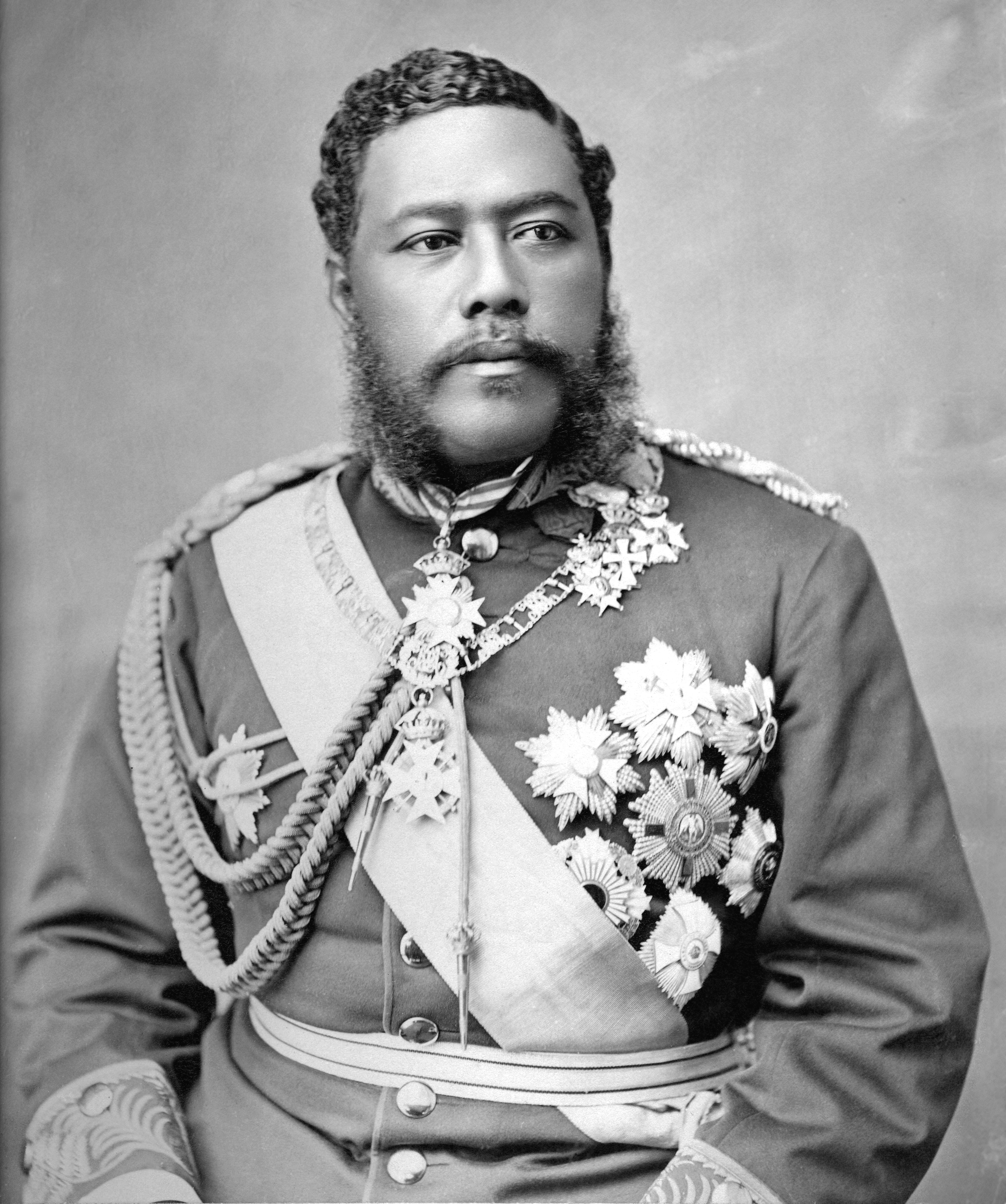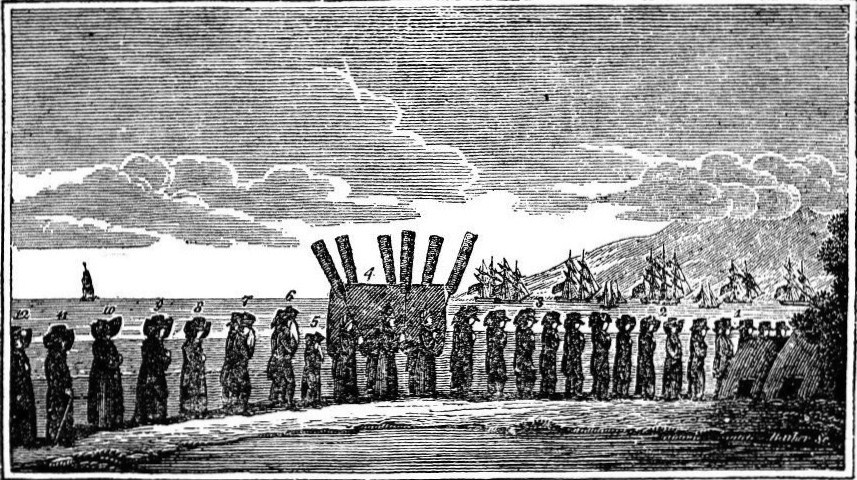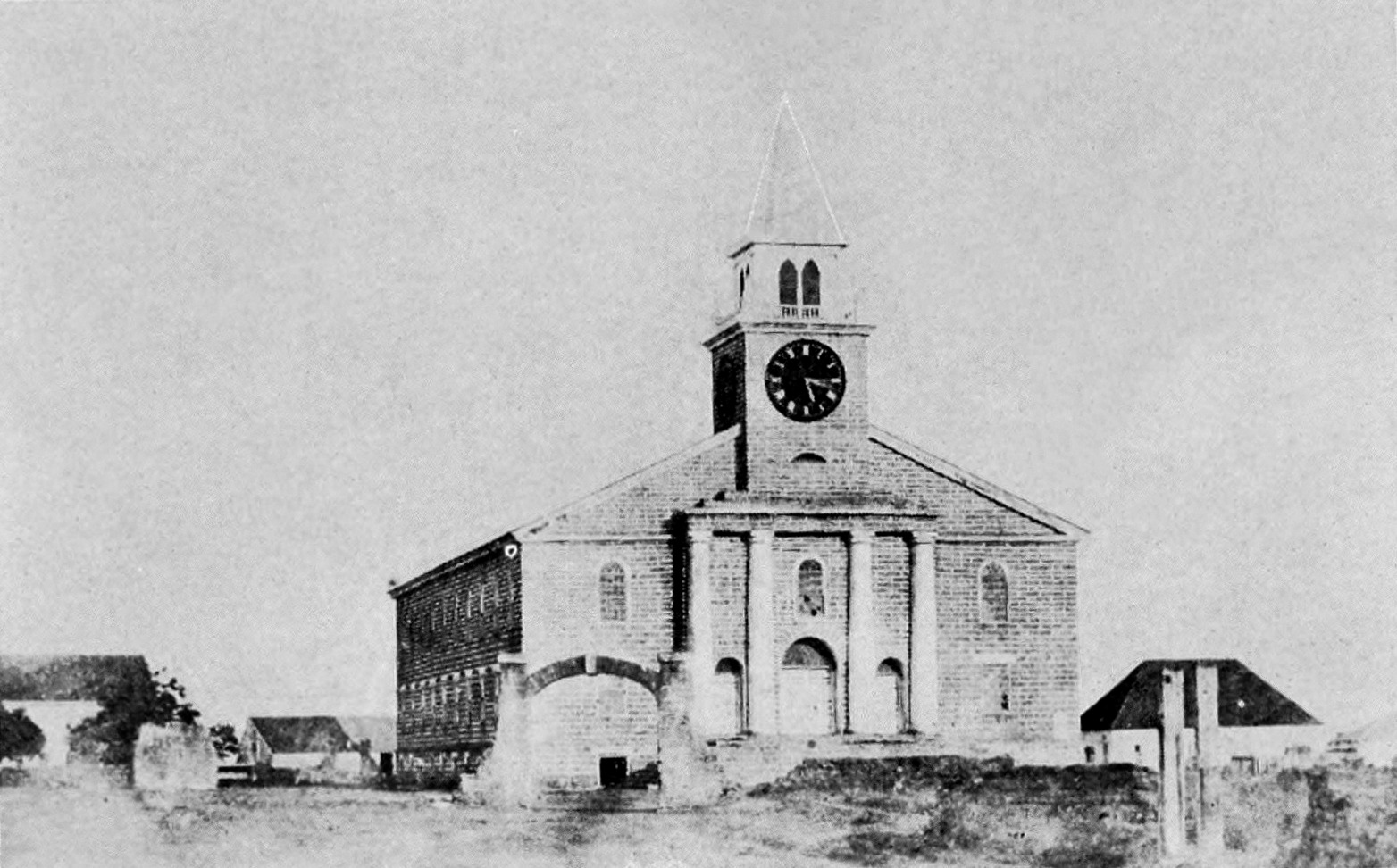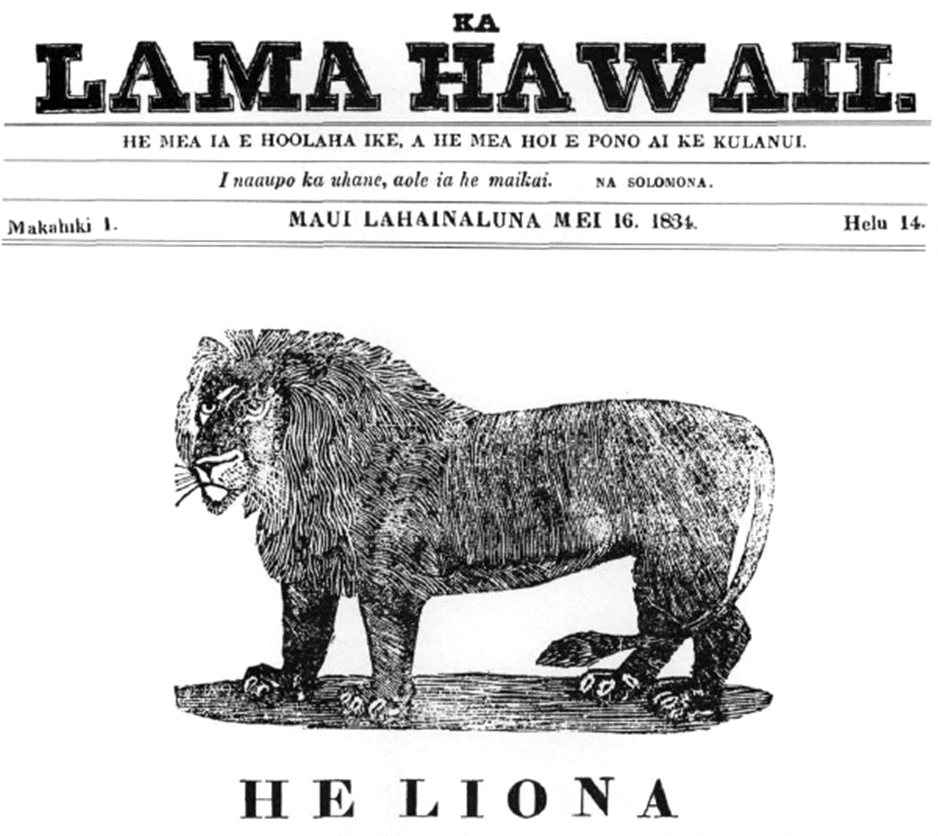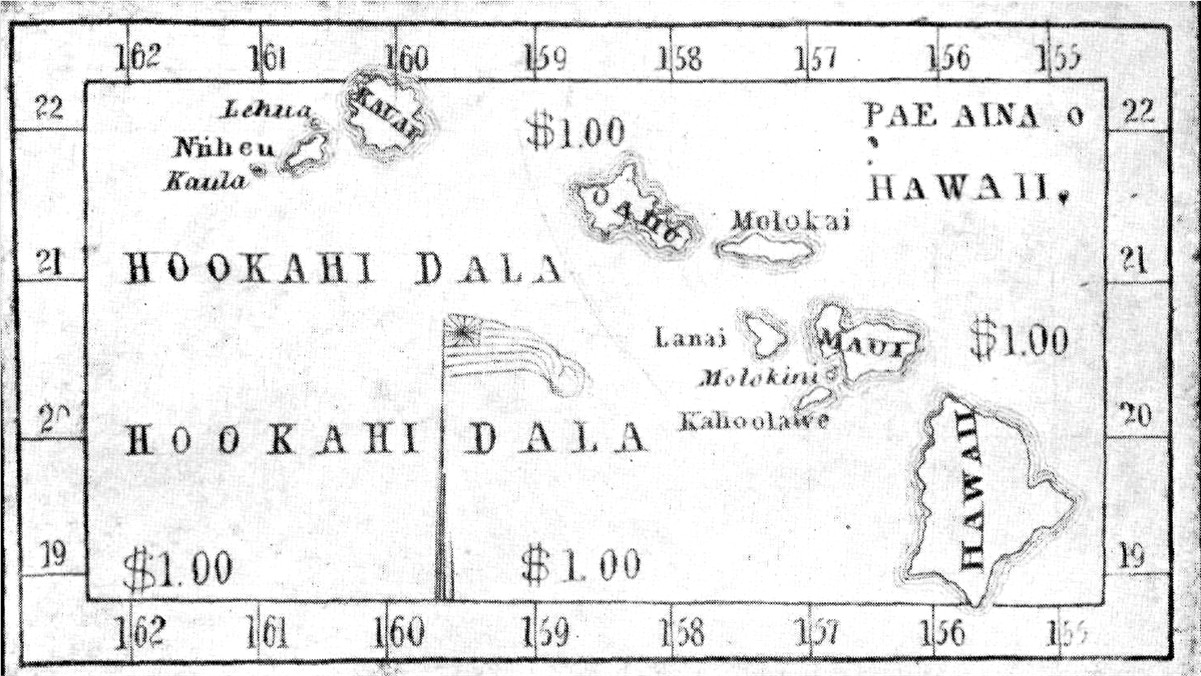|
Haʻalilio
Timoteo or Timothy Kamalehua Haʻalilio (1808 – December 3, 1844) was a royal secretary and first diplomat of the Kingdom of Hawaii. He is best known for helping Hawaii in gaining recognition from Britain, France, and the United States as an independent sovereign nation. Life Haʻalilio was born early in the 19th century, probably 1808. He was the son Koeleele (or Koelele), and his wife Kipa, in some accounts Eseta (Esther) Kipa. He was the half-brother of Levi Haʻalelea, who later became a husband of Princess Kekauōnohi. He was of the aliʻi class or Hawaiian nobility. He was included in the first English school set up by Hiram Bingham I in Honolulu around April 1821. In 1823 William Richards joined the mission, and became a teacher and friend for the rest of his life. After learning of the death of King Kamehameha II in 1825, Haʻalilio was selected to be the royal secretary of King Kamehameha III. Jean Baptiste Rives who had served as Kamehameha II's secretary had been ... [...More Info...] [...Related Items...] OR: [Wikipedia] [Google] [Baidu] |
Haʻalelea
Levi Haʻalelea ( – October 3, 1864) was a high chief and member of the Hawaiian nobility during the Hawaiian Kingdom. He initially served as a kahu (royal caretaker) and konohiki (land agent) for High Chief Leleiohoku, one of the grandsons of Kamehameha I. He later became abHulumanu (court favorite) in the royal court of Kamehameha III and eventually served as Chamberlain for the court. He married Kekauʻōnohi, the granddaughter of Kamehameha I. These connections to the ruling dynasty gave him access to vast landholding during the land division of the Great Mahele in 1848. Active in politics, he was a member of the Privy Council of State and served in the House of Nobles. In later life, he helped the early Mormon missionaries to the islands by leasing them land and eventually converted to that faith. Early life and family Born circa 1822 in Lahaina, Maui, his father was Haʻaloʻu, the Governor of the island of Molokai under Prime Minister Kalanimoku, and his mother was Kip ... [...More Info...] [...Related Items...] OR: [Wikipedia] [Google] [Baidu] |
Kingdom Of Hawaii
The Hawaiian Kingdom, or Kingdom of Hawaiʻi (Hawaiian language, Hawaiian: ''Ko Hawaiʻi Pae ʻĀina''), was a sovereign state located in the Hawaiian Islands. The country was formed in 1795, when the warrior chief Kamehameha the Great, of the independent island of Hawaii (island), Hawaiʻi, conquered the independent islands of Oahu, Oʻahu, Maui, Molokai, Molokaʻi and Lanai, Lānaʻi and unified them under one government. In 1810, the whole Hawaiian archipelago became unification of Hawaii, unified when Kauai, Kauaʻi and Niihau, Niʻihau joined the Hawaiian Kingdom voluntarily. Two major dynastic families ruled the kingdom: the House of Kamehameha and the House of Kalākaua. The kingdom won recognition from the major European powers. The United States became its chief trading partner and Hawaiian Kingdom–United States relations, watched over it to Monroe Doctrine, prevent other powers (such as British Empire, Britain and Empire of Japan, Japan) from asserting hegemony. In 1 ... [...More Info...] [...Related Items...] OR: [Wikipedia] [Google] [Baidu] |
Hawaiian Kingdom
The Hawaiian Kingdom, or Kingdom of Hawaiʻi ( Hawaiian: ''Ko Hawaiʻi Pae ʻĀina''), was a sovereign state located in the Hawaiian Islands. The country was formed in 1795, when the warrior chief Kamehameha the Great, of the independent island of Hawaiʻi, conquered the independent islands of Oʻahu, Maui, Molokaʻi and Lānaʻi and unified them under one government. In 1810, the whole Hawaiian archipelago became unified when Kauaʻi and Niʻihau joined the Hawaiian Kingdom voluntarily. Two major dynastic families ruled the kingdom: the House of Kamehameha and the House of Kalākaua. The kingdom won recognition from the major European powers. The United States became its chief trading partner and watched over it to prevent other powers (such as Britain and Japan) from asserting hegemony. In 1887 King Kalākaua was forced to accept a new constitution in a coup by the Honolulu Rifles, an anti-monarchist militia. Queen Liliʻuokalani, who succeeded Kalākaua in ... [...More Info...] [...Related Items...] OR: [Wikipedia] [Google] [Baidu] |
Kekauʻōnohi
Keahikuni Kekauʻōnohi (c. 1805–1851) was a Hawaiian high chiefess who was a member of the House of Kamehameha. She was granddaughter to King Kamehameha I and one of the wives of Kamehameha II. Her Christian name is disputed; it is given as Mikahela in the 1848 Mahele Book and as Miriam in later sources. Biography She was born circa 1805 at Lahaina, Maui. Her father was Kahōʻanokū Kīnaʻu. Her mother was Kahakuhaʻakoi Wahinepio, sister of Boki and Kalanimoku and granddaughter of Alii Nui, Kekaulike of Maui. Her father was a son of Kamehameha I and his wife Peleuli, daughter of Kamanawa, one of the royal twins. She married her uncle Kamehameha II. She was one of his five wives. Others were Kamāmalu, Pauahi, Kīnaʻu, and Kekāuluohi. She was the youngest, but Kamāmalu was Liholiho's favorite. She was at the famous meal when the ''kapu'' system was overturned in 1819, known as the ʻAi Noa. After Liholiho's death in London, she went to Kauaʻi to live wit ... [...More Info...] [...Related Items...] OR: [Wikipedia] [Google] [Baidu] |
Kawaiahaʻo Church
Kawaiahaʻo Church is a historic Congregational church located in Downtown Honolulu on the Hawaiian Island of Oʻahu. The church, along with the Mission Houses, comprise the Hawaiian Mission Houses Historic Site, which was designated a U.S. National Historic Landmark (NHL) in 1962. and In 1966 it and all other NHLs were included in the first issuance of the National Register of Historic Places. At one time the national church of the Hawaiian Kingdom and chapel of the royal family, the church is popularly known as Hawaiʻi's Westminster Abbey. The name comes from the Hawaiian noun phrase ''Ka wai a Haʻo'' (the water of Haʻo), because its location was that of a spring and freshwater pool of a High Chiefess Haʻo. It has also been called the "hale pule lahui", the Great Stone Church, the Hawaiian Tabernacle (luakini), the Mother Church, the Kingʻs Church, the Kingʻs chapel, and the "Aliʻi Church". Today, Kawaiahaʻo continues to use the Hawaiian language for parts of t ... [...More Info...] [...Related Items...] OR: [Wikipedia] [Google] [Baidu] |
Lahainaluna School
Lahainaluna High School is a public high school with the grades 9-12 located in Lahaina (on the island of Maui). Lahainaluna High School is also a public boarding school. It was founded in 1831 as a Protestant missionary school, originally named Lahainaluna Seminary. The early missionaries who arrived in Lahaina in 1823 explained to the Hawaiian Royalty the importance of an educational institution in the American style. A number of the pioneers, students and teachers are buried in a small graveyard behind several buildings on the campus. It was the first formal European-American style school founded in Hawaii and has continued to operate to this day. History and traditions American William Richards founded the missionary station in Lahaina in 1823. In June 1831, Lorrin Andrews was chosen as first principal of a seminary for boys and young men. The site was named Lahainaluna for "upper Lahaina". On September 5, 1831, classes began in thatched huts with 25 Hawaiian young men as ... [...More Info...] [...Related Items...] OR: [Wikipedia] [Google] [Baidu] |
Lahainaluna High School
Lahainaluna High School is a public high school with the grades 9-12 located in Lahaina (on the island of Maui). Lahainaluna High School is also a public boarding school. It was founded in 1831 as a Protestant missionary school, originally named Lahainaluna Seminary. The early missionaries who arrived in Lahaina in 1823 explained to the Hawaiian Royalty the importance of an educational institution in the American style. A number of the pioneers, students and teachers are buried in a small graveyard behind several buildings on the campus. It was the first formal European-American style school founded in Hawaii and has continued to operate to this day. History and traditions American William Richards founded the missionary station in Lahaina in 1823. In June 1831, Lorrin Andrews was chosen as first principal of a seminary for boys and young men. The site was named Lahainaluna for "upper Lahaina". On September 5, 1831, classes began in thatched huts with 25 Hawaiian young men ... [...More Info...] [...Related Items...] OR: [Wikipedia] [Google] [Baidu] |
Gerrit P
Gerrit is a Dutch male name meaning "''brave with the spear''", the Dutch and Frisian form of Gerard. People with this name include: * Gerrit Achterberg (1905–1962), Dutch poet * Gerrit van Arkel (1858–1918), Dutch architect * Gerrit Badenhorst (born 1962), South African powerlifter and professional strongman competitor * Gerrit Battem (c. 1636 – 1684), Dutch landscape painter * Gerrit Beneker (1882–1934), American painter and illustrator * Gerrit Berckheyde (1638–1698), Dutch painter * Gerrit Berkhoff (1901–1996), Dutch chemist and university rector * Gerrit Cornelis Berkouwer (1903–1996), Dutch theologian * Gerrit Berveling (born 1944), Dutch Esperanto author * Gerrit Blaauw (born 1924), Dutch computer engineer * Gerrit de Blanken (1894–1961), Dutch pottery artist * Gerrit van Bloclant (1578–1650), Dutch Renaissance painter * Gerrit Bol (1906–1989), Dutch mathematician * Gerrit Braamcamp (1699–1771), Dutch distiller, timber merchant and art coll ... [...More Info...] [...Related Items...] OR: [Wikipedia] [Google] [Baidu] |
Cyrille Pierre Théodore Laplace
Cyrille Pierre Théodore Laplace (7 November 1793 – 24 January 1875) was a French navigator famous for his circumnavigation of the globe on board ''La Favorite''. He was pivotal in the opening of French trade in the Pacific and was instrumental in the establishment of the Hawaiian Catholic Church. He achieved the rank of captain. Early life Laplace was born at sea on 7 November 1793. He joined the French Navy and fought in the Indian and Atlantic Oceans, along with battles in the West Indies. He was promoted from Aspirant to Ship-of-the-Line Lieutenant in 1823, and to Frigate Captain in 1828. He had been awarded he Cross of Saint-Louis in 1825. He, at some point, was in command of a schooner in Gorée, Senegal. Voyage of ''La Favorite'' As British, American and Dutch voyages began solidifying their interests in Australia, Hawaii and New Guinea, the French government sought to secure the religious freedoms and rights of French residents in the South Pacific. Voyages such as ... [...More Info...] [...Related Items...] OR: [Wikipedia] [Google] [Baidu] |
1840 Constitution Of The Hawaiian Kingdom
The 1840 Constitution of the Hawaiian Kingdom titled was the first fully written constitution for the Hawaiian Kingdom. The need for a constitution was originally intended as a manner of laws set forth to control the Native Hawaiian population with a Western style and legal framework, giving less severe punishments, such as being exiled, than was the traditional custom until the 1840s. Christianity had failed to change many behaviors of the Hawaiian population, even with the support of the families. Adultery and many other sexual relations became forbidden. Hawaiians were arrested and sentenced to severe punishments that were not well organised. The exiled had little food and could easily swim away from the islands and the prison at Honolulu Fort. The issue became worse as fewer pardons from the were available, and the overall sentencing then became much more severe for the native population. Overview The constitution was enacted on October 8, 1840, by King Kamehameha III and K ... [...More Info...] [...Related Items...] OR: [Wikipedia] [Google] [Baidu] |
Legislature Of The Hawaiian Kingdom
The Legislature of the Hawaiian Kingdom () was the bicameral (later unicameral) legislature of the Hawaiian Kingdom. A royal legislature was first provided by the 1840 Constitution and the 1852 Constitution was the first to use the term Legislature of the Hawaiian Islands, and the first to subject the monarch to certain democratic principles. Prior to this the monarchs ruled under a Council of Chiefs (ʻAha Aliʻi). Structure The Legislature from 1840 to 1864 was bicameral and originally consisted of a lower House of Representatives and an upper House of Nobles as provided for under the Constitutions of the Kingdom of 1840 and 1852, until abolished by the 1864 Constitution which then provided for a unicameral Legislature. House of Nobles The members of the upper House of Nobles (Hale ʻAhaʻōlelo Aliʻi) were appointed by the Monarch with the advice of his Privy Council. It also served as the court of impeachment for any royal official. Members were usually Hawaiian ali� ... [...More Info...] [...Related Items...] OR: [Wikipedia] [Google] [Baidu] |
John Papa ʻĪʻī
John (Ioane) Kaneiakama Papa ʻĪʻī (1800–1870) was a 19th-century educator, politician and historian in the Kingdom of Hawaii. Life ʻĪʻī was born 1800, in the month of Hilinehu, which he calculated to be August 3, in later life. He was born near the Hanaloa fishpond in Kūmelewai, Waipiʻo, ʻEwa, Oʻahu. His mother was Kalaikāne Wanaoʻa Pahulemu while he is considered to have two fathers (a tradition called ''poʻolua),'' either Kuaʻena Mālamaʻekeʻeke or Kaiwikokoʻole, although ʻĪʻī claimed the former as his father because he did not resemble Kaiwikokoʻole. His family belonged to the Luluka branch of the Luahine line, hereditary ''kahu'' (caretaker) to the chiefs of Hawaii. His cousin was Daniel Papa ʻĪʻī. ʻĪʻī was raised under the traditional kapu system and trained from childhood for a life of service to the high chiefs. At the age of ten he was taken to Honolulu by his uncle Papa ʻĪʻī, a ''kahu'' of Kamehameha I, to become a companion and ... [...More Info...] [...Related Items...] OR: [Wikipedia] [Google] [Baidu] |


